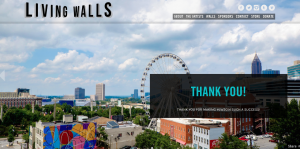Living Walls is a non-profit organization in Atlanta that strives to educate Atlantans about public space and widen perspectives through street art. The organization was founded in 2010 and not only showcases art, but also uses it to change the built environment for the better by jazzing up the city walls with color and life. Living Walls hosts an international conference every year in Atlanta that brings in twenty artists form around the world. During the conference, each artist produces their own wall, providing the city with diverse street art. Below is a video from Youtube that provides more information about the artists and how the Living Walls organization has impacted them and the city of Atlanta.
The Living Walls digital space is set up rather simply. The homepage consists of three photographs that rotate as the background, the organization’s logo, and several tabs that link to different parts of the site: About, The Artists, Walls, Sponsors, Contact, Store, and Donate. By exploring these tabs viewers can learn about the organization’s goals and concepts, the artists and their origins, where the walls are located, who sponsors them, and information on how to donate. The store tab is currently under construction, so I was not able to delve into that part of the site. Each one of these tabs is clean cut and gives a short summary of information. I found the “Walls” tab and “The Artists” tab to be the most interesting. The “Walls” tab displays an interactive map showing where each wall is located, the address, and a link to the artist’s profile. “The Artists” tab shows a list of all ninety-five artists, where they are from, photographs of their street art in Atlanta, and some even have a short bio. No matter what part of this digital space you are exploring, each page is filled with color. The array of color used throughout the site makes it fun to dig deeper into the world of Living Walls.
The Living Walls digital space advertises itself in a simple and non-invasive way. In the top right corner of the site, logos of five different social media companies are displayed. Clicking on each of these brings you to the Living Walls page for that social media site, such a their Facebook or Instagram pages. This allows viewers to easily access and follow Living Walls on social media. Also, a “Share” button in the bottom right corner of the site provides an opportunity for people to share the Living Walls link on their own social media accounts. This type of marketing tells a lot about what type of audience the non-profit organization is targeting: millennials or others who are actively on social media. Those who are most likely to use this site are artists, Atlantans looking to get involved in the community, young adults/students, and possible sponsors who are looking to donate. Lastly, this site made me feel welcome and sparked my curiosity about Living Walls and I plan to visit some of the murals in the near future.
